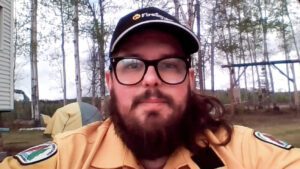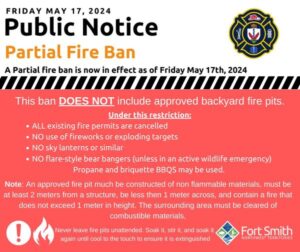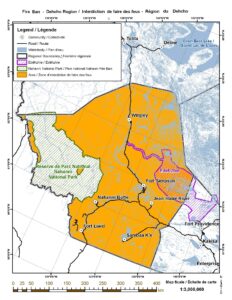Favourable winds and rain have stopped the advance of major wildfires in southern areas of the Northwest Territories, allowing firefighters to make progress in battling the mid-spring blazes.
With the largest fire, southwest of Fort Liard (FS002), about three millimetres of rain fell unevenly in the community since yesterday, NWT Fire reported this morning.
Spokesperson Mike Westwick said the fire hasn’t crossed the river and isn’t expected to move closer to Fort Liard under expected conditions today and tomorrow.
“Still, some relief and help as containment work continues. Slight warming to around 14 to 16 C expected today. Skies have cleared and the air is drying out quickly which could support elevated fire activity by late afternoon,” he stated of the uncontained blaze.

Mike Westwick NWT Fire spokesperson during a May 14 media call. (Image courtesy Microsoft Teams.)
“Winds continuing to come mostly from the northeast, which is favourable for continued progress on containing the fire.”
Another fire, located 40 kms south of Fort Simpson near Check Point on Highway 1 at the Liard junction (FS005), remains is 40 kms west of Jean Marie River.
Some rain showers on Tuesday helped prevent any significant growth, stated NWT Fire.
Heavy equipment and crews will continue to work along the highway. Bombers were able to perform some drops yesterday to help suppress the fire.
This overwinter fire between the Fort Providence Junction and Highway 7 Junction (FS004) which saw this week the multi-day closure of Highway 1 continues to burn on both sides of roadway.
“Numerous values along the highway are at risk. We have confirmed the loss of two structures along this route,” stated NWT Fire.
Teams and heavy equipment are working along the highway to cap growth to the east and will continue to protect assets as best possible. Check road closures before travelling.
Road closures as of Friday morning include: Nearly 40 kilometres of Highway 7 to the BC border; the 12 kilometre Nahanni Butte access road; and 126 kilometres of Sambaa K’e access road.
Fire danger levels range this weekend from extreme or high in South Slave (Kakisa, Enterprise, Fort Providence and Fort Smith), to high and medium (Hay River).
Dehcho levels range from extreme to high (Nahanni Butte, Fort Simpson), to low and medium (Fort Liard, Wrigley).
 North Slave, Sahtu and Beaufort Delta regions have risk levels from low to high, the threat dropping the further north one goes.
North Slave, Sahtu and Beaufort Delta regions have risk levels from low to high, the threat dropping the further north one goes.
With the May Long Weekend being the traditional start to the camping season, folks heading to campgrounds or anywhere out on the land, should be aware of fire restrictions in Dehcho and South Slave regions.
The South Slave regional ban is set to expire at 11:59 p.m. tonight, stated NWT Fire.
Fort Smith stated online it is moving to a partial fire ban for the community. That means approved backyard fire pits can now be used in the town.
The current regional bans cover all communities and land between them not under federal jurisdiction. The use of fire for exercising Indigenous or treaty rights by Indigenous peoples are exempt from these restrictions.
Some banned activities include: Having open fire outdoors, including in an open fire pit or burn barrel; using firearms with incendiary or tracer ammunition; fireworks or firecrackers; and all burn permits are temporarily cancelled.
The use of closed stoves, barbecues, furnaces, or other devices suitable for containing fire may be used (including legal gas and propane barbecues and fire pits).
Northwest Territories 2024 Wildfire Update: Total active fires: nine; new fires in the last 24 hours: zero; total fires this year: 14; hectares affected: 10,987 Ha.

South Slave map showing area of fire ban, which expires today, May 17. (Image courtesy of GNWT.)

Dehcho map showing area of fire ban, which expires May 24. (Image courtesy of GNWT.)





